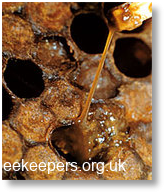Small hive beetle found in Sicily The small hive beetle (SHB), Aethina tumida, is a bee hive pest native to sub-Saharan Africa. The SHB has been accidentally introduced into many countries across the globe, including the USA, Canada, Australia, China and many countries in Latin America. SHB was found in Calabria…
Updated content: Foulbrood advisory leaflet
Our ‘Foulbrood disease of honey bees’ advisory leaflet has been updated. European foulbrood and American foulbrood are the main focus of this leaflet, as they are statutory notifiable diseases in the UK, and must be reported to the NBU. Recognising the signs of these diseases is particularly important for all…
Asian Hornet 2024 Rolling update
To view location of destroyed nests please visit the map page and choose the Asian Hornet map layer As of 24/05/2024: 18 Asian hornets have been reported in the UK 2024. 1 Asian hornet nest has been killed. Sighting Photo Grid Ref: Date initial sighting Date confirmed by…
Irregular inspections and swarm prevention
Book III of Geoffrey Chaucer’s epic Medieval poem, Troilus and Crisedye, contains the line:And after winter folweth grene MayEven with only a cursory understanding of Middle English, it’s pretty obvious that Chaucer is commenting on May being the first month of the year when everything is verdant.Winter is over, the…
Asian Hornet Sightings Update May 2024
On 10th May, a further hornet was found near Four Oaks, East Sussex, in traps that the NBU has been monitoring in the area. This makes a total of five queens caught in this area. Two further hornets have been captured and killed in Kent. On 15th May, a hornet…
Bigger queens, better queens – part 3
The qualities of the queen – her fecundity, longevity, genetics etc. – are the most important influence on colony ‘success’.You could measure that success in terms of reproduction (if free-living, does the colony swarm successfully?) or – of more relevance to a beekeeper – by the weight of the honey…

☣ Important Notice: American Foulbrood Detected
A confirmed case of American Foulbrood (AFB) detected within the 10 km square SE20.
Beekeeping records
All around the country, new beekeepers – fresh from attending a How to start beekeeping winter course – will be buying their first nuc, eagerly watching a bait hive for scout bees, or precariously teetering up a stepladder trying to entice a lost swarm (someone else’s) into a skep.Your first…
Honey bee starvation
Starvation of honey bees – recognition and prevention During prolonged cold, wet periods and/or when there is a lack of forage, honey bee colonies may use up all their honey or sugar stores. This can frequently happen in spring when colonies are using up their last remaining winter stores to…
Informed decisions
One of the attractions of beekeeping is the seasonal variation, both within a single season and between one year and the next.Early colony expansion enables the spring nectar flow to be exploited, and leads simultaneously – almost inevitably and so reasonably predictably – to swarming. Colonies are re-queened (or re-queen…
